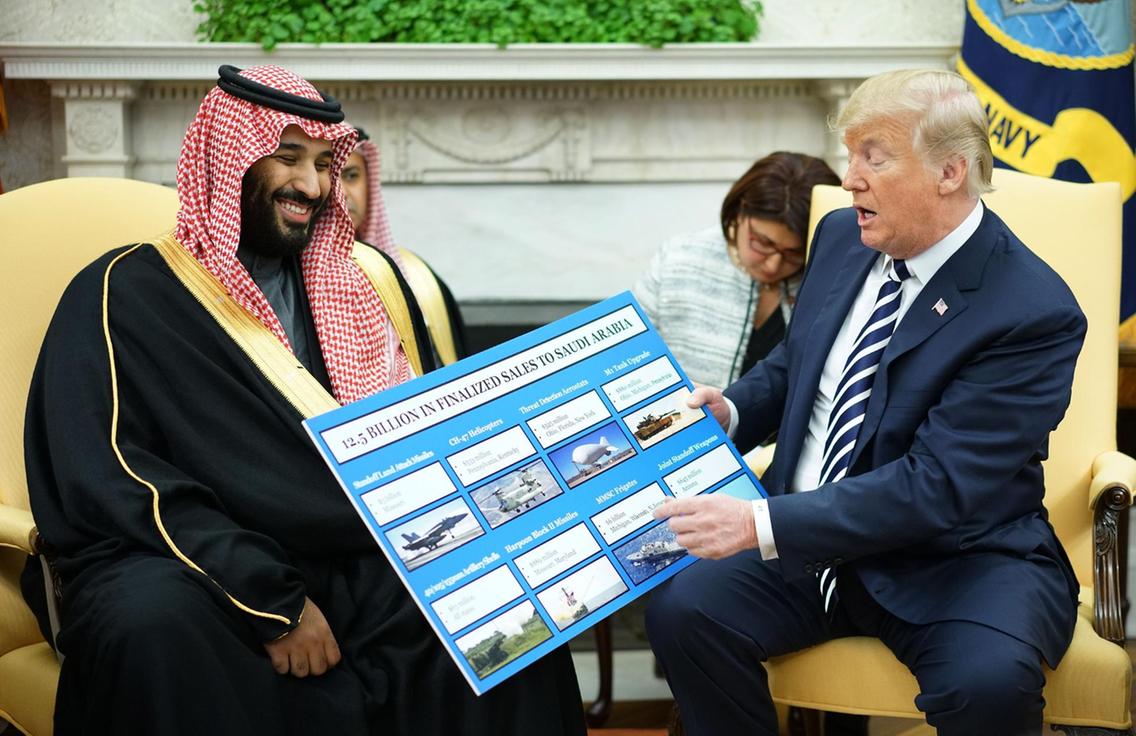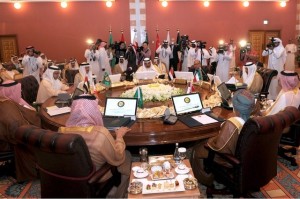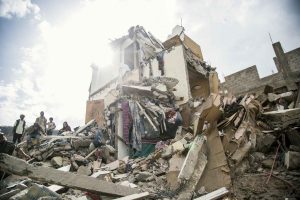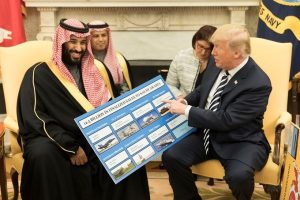by Pieter D. Wezeman
Throughout the Middle East, many governments have placed a heavy emphasis on military force as a central tool for pursuing their political agendas and foreign policy aims and for dealing with perceived threats internally and abroad. Many states in the region have used their militaries in violent conflicts that have led to widespread destruction and hampered economic development. Militarization in the region is at a high level, as demonstrated by the fact that several states have steeply increased their arms imports in the past 10 years and that, in 2017, 7 of the 10 countries in the world with the highest military burden were in the Middle East.
This topical backgrounder puts a spotlight on armament developments in Saudi Arabia, the country with the highest levels of military spending and arms imports in the Middle East. It aims to contribute to the efforts by SIPRI to gain a better understanding of the impact of militarization on security, conflict, peace and development in the region.
Saudi Arabia’s Military Involvement in Conflicts in the Middle East
Since the spring of 2015, Saudi Arabia has been leading a coalition of states in a military intervention against rebel forces in Yemen. The intervention has involved airstrikes, ground operations and an aerial and naval blockade of Yemen. Instead of a quick victory or resolution to the conflict, fighting has continued and the warring parties have been accused of violations of international humanitarian law. United Nations bodies and non-governmental organizations have accused Saudi Arabia of widespread and systematic attacks on civilian targets. The conflict in Yemen has caused tens of thousands of casualties and the situation there is currently considered to be the worst humanitarian crisis in the world. The fighting—and the blockade in particular—has disrupted imports of food, fuel and medical supplies.
Saudi Arabia is also militarily involved in other conflicts—such as providing support for rebel groups in Syria, attempting to use military assistance to gain influence in Lebanon and fighting Shiite minority groups in the eastern province of Saudi Arabia. Although the various conflicts throughout the Middle East are complex, it is widely believed that they can be at least partly explained by regional power struggles (such as those between Saudi Arabia and Iran, and Saudi Arabia and Qatar) or involving Israel, Turkey, the United Arab Emirates and the United States. Further proxy wars similar to those in Syria or Yemen—or even a direct confrontation between Saudi Arabia and its allies, and Iran and its allies—remain a possibility. The high level of militarization in Saudi Arabia requires analysis to understand how this contributes to the country’s ability and inclination to become militarily involved in regional conflicts and tensions.
Saudi Arabian Military Expenditure
The high level of militarization in Saudi Arabia is reflected in its high level of military expenditure. SIPRI estimates that Saudi Arabia was the third largest military spender in the world in 2017 and by far the largest military spender in the Middle East. Looking at the decade 2008–17, its military spending increased by 74 per cent between 2008 and 2015 to $90.3 billion, the highest level ever. Following the fall in oil prices—and thus in government revenues—military spending fell by 29 per cent in 2016. It increased again by 9.2 per cent in 2017 to $69.4 billion, equivalent to 10 per cent of the country’s gross domestic product (GDP). In comparison, all the other countries among the top 15 military spenders in the world dedicate less than 4.2 per cent of GDP to the military. At $2107, Saudi Arabia’s per capita military spending was higher than any other country in the world in 2017.
It is important to stress that the figures for Saudi Arabian military spending are estimates because Saudi Arabia’s public documents on budgets and actual spending contain only a minimal amount of information on military spending and no disaggregated data on spending on the paramilitary forces that report to the state’s Ministry of Interior. This reflects the overall lack of transparency in military matters in the country.
The Saudi Arabian Arms Industry
Given its overall investment in the military, Saudi Arabia’s attempts to build an indigenous arms industry have yielded limited results. A government plan to reorganize and diversify the economy, launched in 2017 and known as Vision 2030, contains vague ambitions for the development of an arms industry. The aim is to ‘localize over 50 per cent of [Saudi] military equipment spending by 2030’, up from 2 per cent in 2017. A new company has been created, Saudi Arabian Military Industries (SAMI), by consolidating several existing companies. SAMI aims to ‘assume a leading role in the global military industry sector by 2030’. Given the challenges that Saudi Arabia faces in developing its industrial base more generally, and the difficulties other countries have faced when pursuing military industrialization, the extent to which these goals can be achieved within a 14-year period is highly questionable. Nevertheless, Saudi Arabia remains highly dependent on arms imports, and the developing indigenous Saudi arms industry can be expected to be based on imported technology and expertise for many years to come.
Arms Import Trends in Saudi Arabia
Despite fluctuations, Saudi Arabia was the second largest arms importer in the world in the period 1998–2017. There was a low point in the period 2000–2008 when the country’s armed forces integrated large volumes of weapons that were ordered in the aftermath of Iraq’s invasion of Kuwait in 1990–91 and delivered in the late 1990s. This was followed by a steep increase in the volume of arms imports in 2013–2017, to a level higher than any previous five-year period and substantially higher than other countries in the Gulf region.
Saudi Arabia’s Import of Advanced Weapons
The SIPRI arms transfers database yields a long list of arms imported by Saudi Arabia in the period 2013–2017. As these are generally advanced weapons, Saudi Arabia is the most well-armed country in the Gulf region in terms of its inventory of modern equipment. Only a few examples are necessary to illustrate the types of recently acquired weapons that are important to Saudi Arabia’s capability to wage war in Yemen while at the same time conducting internal military operations, maintaining a military capability at the border with Iraq, facing Iran militarily and contemplating the possibility of deploying its military in Syria.
A combination of newly procured air force assets has increased the reach and strike power of the Saudi Arabian armed forces. The Royal Saudi Air Forces (RSAF) uses several types of combat aircraft, all of which have been used in the war in Yemen. During the 1990s, the USA supplied 72 F-15S. Starting in 2016, these began being replaced by 154 F-15SA, a heavily modernized version of the F-15S ordered from the USA in 2011. In addition, the USA continues to deliver large quantities of ordnance for these aircraft, such as SLAM-ER cruise missiles with a 280-kilometre range, and a variety of guided bombs that have been used in Yemen.
The United Kingdom supplied Tornado combat aircraft in the 1990s, and 84 of these were upgraded in the period 2007–13 to enable them to carry new guided weapons, such as Storm Shadow cruise missiles which have a range of at least 250 kilometres. These and other guided weapons delivered by the UK have been used in Yemen since 2015, and deliveries are ongoing. The UK also delivered 72 Typhoon combat aircraft in 2009–17 and contract negotiations for 48 more were continuing in 2018.
Saudi Arabia bases its long-range strike capability on aircraft, but it also maintains a secretive Strategic Missile Force equipped with a small arsenal of DF-3 ballistic missiles. These have a range of at least 2500 km and were supplied by China in 1988. There are indications that this force was modernized around 2010.
A small fleet of tanker aircraft extends the range and increases the payload of Saudi Arabia’s combat aircraft. To supplement its existing tanker aircraft, six new A-330 MRTT built by the trans-European Airbus consortium were delivered from Spain between 2011 and 2015. The significance of this tanker fleet was highlighted when, in November 2018, Saudi Arabia stated that it no longer required aerial refuelling support from the USA for its operations in Yemen ‘because it could now handle it by itself’. Nonetheless, it remains uncertain just how independent the country really is in this regard.
Sophisticated intelligence, surveillance, reconnaissance, and command and control equipment is crucial to the Saudi Arabian military. Five E-3 airborne early warning and control (AEW&C) aircraft were acquired from the USA in the 1980s and are currently being extensively upgraded. In addition, Sweden supplied two Erieye AEW&C aircraft in 2014.
At the same time, Saudi Arabia is improving its capability to defend against air and missile attacks. In 2014–17 it received 21 Patriot PAC-3 air defence systems from the USA, which have been used with mixed success to defend Riyadh and other places in Saudi Arabia against ballistic missiles fired by Houthi rebels from Yemen. In November 2018 Saudi Arabia signed an agreement with the USA to buy THAAD systems, the most advanced anti-missile system available.
Together, the increasing reach of the RSAF combined with improved target acquisition capabilities and evolving air and missile defence systems widen the technological gap between the Saudi Arabian arsenal and that of its main rival, Iran.
Saudi Arabia’s land and naval forces are also continuously being improved. In the period 2013–17, for example, the army and National Guard received over 3000 armoured vehicles from Austria, Canada, France, Georgia, South Africa, Turkey and the USA. Many of the vehicle types delivered in recent years have been highly visible in coverage of the war in Yemen. The Royal Saudi Naval Forces (RSNF), which play an important role in the blockade of Yemen, has initiated several major procurement projects in recent years, including orders for at least 33 patrol boats from Germany in 2014, two large patrol boats from France in 2015, 4 highly advanced frigates from the USA in 2017 and 5 corvettes from Spain in 2018.
One aspect of Saudi Arabian military activities remains especially difficult to assess as reliable information is so scarce—the extent of the support it provides to its allies in the Middle East, often in competition with Iranian support to its allies. For example, there are strong indications that Saudi Arabia has supplied significant amounts of weaponry to rebel forces in Syria and to government forces or related armed groups in Yemen. These weapons come from existing Saudi Arabian stocks or have reportedly been procured specifically for this purpose from Bulgaria, Croatia and Serbia, among others.
Where Do Saudi Arabia’s Arms Come from?
In 2013–17, 61 per cent of Saudi Arabia’s arms imports came from the USA and 23 per cent from the UK. Several other West European countries supplied most of the rest.
Efforts by China and Russia to sell weapons to Saudi Arabia have had limited success. However, the deliveries of unmanned aerial vehicles (UAVs, or drones) from China since 2014—while few in number and lower in capability compared to the weapons delivered by the USA and the UK—are still significant as they could mark the beginning of Saudi Arabia’s efforts to diversify the sourcing of its weapons beyond Western countries.
This diversification is likely to be driven by efforts to improve its bargaining position on the arms market, to widen and deepen its international political network and in order to minimize the effects of the restrictive arms export policies of current supplier states on Saudi Arabian arms procurement. The latter has been of increased relevance as a number of European states critical of Saudi Arabia’s use of military force in Yemen successively announced severe restrictions on arms exports to the Kingdom. The Netherlands led the way in early 2016 and by late 2018 Germany, Finland and Denmark had followed. However, the main European arms exporters to Saudi Arabia —such as the UK, France, Spain and Italy—have discussed such restrictions but not implemented them.
Similar discussions about restricting arms sales to Saudi Arabia have been ongoing in the USA. However, the administration of US President Donald J. Trump decided not to go down this path, arguing that arms supplies are important for sustaining relations between the USA and Saudi Arabia; the U.S. administration sees Saudi Arabia as playing a crucial role in maintaining security in the Middle East as a bulwark against terrorism and as a key player in countering Iranian influence. In addition, Trump has argued that arms sales to Saudi Arabia are a major source of export revenue and involve a significant number of jobs. Whereas the security-related arguments are difficult to quantify, the economic arguments have been heavily criticized as inflated. For example, according to U.S. government sources the value of deliveries of military goods and services to Saudi Arabia peaked in 2017 at $6.2 billion, or 0.27 per cent of total goods and services exported by the USA in 2017.
Conclusions
Lack of transparency in military matters makes it difficult to determine the extent to which Saudi Arabia’s high levels of military spending and arms procurement are driven by defensive or offensive motives, military or prestige considerations, internal power play or the possibility for government officials to enrich themselves. However, it is clear that Saudi Arabia is no longer just stocking up on weapons. It is actually using them on a large scale in an offensive operation in Yemen. Preparations for the future use of armed force elsewhere should not be excluded as a motive for the continuing high level of militarization.
Saudi Arabia might perceive its failure to win the war in Yemen as an indication of the limitations of its military arsenal. On the other hand, it could perceive the operations in Yemen as preventing a complete takeover of Yemen by allies of Iran, forcing the Houthi rebels to agree on negotiations and providing an opportunity for its armed forces to gain significant experience of warfare. Such perceptions combined with further arms acquisitions that enhance the reach and strike power of its armed forces may embolden the Saudi leadership to view the use of force as an increasingly central part of its foreign policy, regional power aspirations and responses to real or perceived threats from, among others, Iran, Qatar, or internal groups.
As Yemen dramatically illustrates, there are major risks for national and regional security, stability, peace, development and the humanitarian situation that relate to militarized foreign and security policies in the Middle East. States should therefore reassess the possible short- and long-term consequences of their arms exports to Saudi Arabia, ensure that a questionable narrative of economic gain does not drive such arms sales and consider if and how arms supplies can have a role at all in conflict resolution in the Middle East.
Pieter D. Wezeman is a Senior Researcher with the SIPRI Arms Transfers and Military Expenditure Programme. His area of research is the global production and proliferation of conventional arms with a special focus on military expenditure and arms procurement in and arms transfers to the Middle East and Africa. He also monitors multilateral arms embargoes and maintains the SIPRI database on that issue.
Reposted, with permission, from SIPRI.org.






If we did not have Ayatollahs in Iran, a lot of people would lose a lot of money selling arms to scary Arabs.
When are the politicians going to stop kissing the stone cleaned asses just for money?
Reading this article one would imagine that the Saudi’s military is the next Wehrmacht- bent on invading the world. As Senator Grahams, who used to be a big Saudi supporter, said ‘(Saudis) can’t fight (its way) out of a paper bag’. There are many funny youtube videos of Saudi soldiers abandoning their M1 Abrams tanks or other fighting vehicle in Yemen and running away. The Saudi military can only bomb women and children from high in the sky. I am not sure how this plays into Pieter Wezeman’s equation of Saudi power? My Yemeni friends tell me that the rumor in Sanaa is that MBS is an Iranian agent since he has been a gift to Iran with his actions.